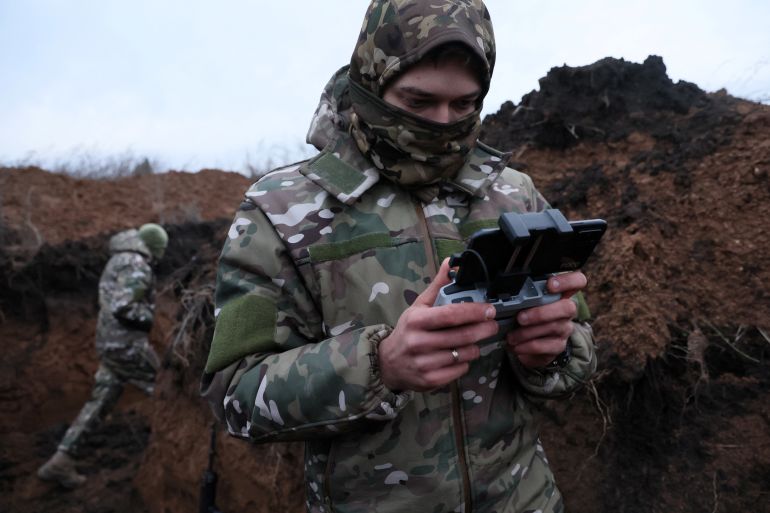‘Eyes and ears’: Could drones prove decisive in the Ukraine war?
How Ukraine is looking to drones, used for reconnaissance and guided-missile attacks, to win the war.

Ivan Ukraintsev, a stern-faced insurance broker turned director of a wartime charity providing crucial aid to Ukraine’s military forces, is on a mission: to help Ukraine win the drone war.
He squints as the February sun streams through the windows of a characterless Kyiv office complex. Outside, a siren wails, signalling the end of an air raid alert owing to military aircraft taking off and circling the skies in neighbouring Belarus. Ivan doesn’t flinch. He is a polite but no-nonsense character, and he is here to talk about drones.
“If we [Ukraine] had enough drones, we could end this war in two months,” he says firmly.
Ivan, who heads up the charity Starlife, had recently returned from overseeing a drone delivery to Bakhmut, a city in eastern Ukraine that has become the focal point for months of bloody battles between Ukrainian and Russian forces. Trench warfare, pockmarked and corpse-ridden swathes of no man’s land, and constant artillery bombardments have drawn comparisons to battlefield conditions during World War I.
There is, however, one key difference: the countless drones hovering in the skies day and night. It is a 21st century addition to conventional warfare that Ivan believes could prove to be the deciding factor in the war in Ukraine.
‘You stop having emotions’
Ivan flicks out his phone and pulls up a video of three Ukrainian soldiers dressed in camouflage clothing on the roof of an apartment block in the war-torn outskirts of Bakhmut. The low lighting suggests it is either early morning or evening.
One of the soldiers pulls a pair of FPV (first-person view) goggles over his head. They appear similar to snorkelling goggles but are encased in hard plastic and fitted with a small screen inside.
Using both hands, he carefully squeezes a set of toggles on a wireless handheld controller between his fingers and presses them gently forwards. A loud buzzing sound can be heard. A drone, the size of a computer laptop, lifts off the ground and out over the ruined cityscape. Another soldier holds onto the drone operator’s belt so he doesn’t lose balance and stumble off the edge of the building. This is a custom-made Ukrainian FPV Kamikaze drone, so named because after taking off, it will not return.
Ivan flicks through his phone until footage collected from the drone’s camera appears. A lone Russian soldier meanders through a network of muddy trenches a hundred metres (330 feet) below the drone lens. The drone begins a rapid descent, honing in on the soldier. Eventually, the man looks up, the drone so close you can make out the expression of horror on his face. The footage ends abruptly. The drone will have exploded a second or two later, killing or severely injuring the soldier.
Ivan locks his screen and places his phone on the table. Such wartime footage, including drone strikes, is often circulated on the messaging app Telegram by official military and civilian channels on both sides of the conflict.
Ivan has been hands-on in delivering the drones, which Starlife has purchased through fundraising campaigns, and making sure they are operational on his trips to the front line.
These experiences have left him hardened to the horrors of combat. “When a lot of people die, you stop having emotions. Either you suffer, or you do something,” he explains, referring to the work that keeps him busy.
Despite his sober exterior, Ivan feels empathy towards low-ranked Russian soldiers, who he says are treated “like cannon fodder” by their superiors in the bloody battles around Bakhmut.
He says he believes the oppressive “old-fashioned” hierarchy is to blame. “On the front line in Bakhmut, you see the Russian commanders have no respect for their soldiers,” he says. “They use them as a disposable resource. You can see 10 soldiers being sent out of the trenches, so they can pinpoint where we strike at them from. They use them as bait because as soon as we regroup somewhere else, they send another 10 and another.”
The reliance on drones as a tactical technology continues to exponentially increase for both sides as the war in Ukraine continues into its 14th month.
The drones’ functions vary greatly, from reconnaissance missions to guided-missile attacks. They can also vary in size and capabilities from repurposed commercial drones, such as the DJI Mavic 3, which costs less than $2,000 and is mainly used for surveillance purposes, to combat drones such as the Turkish-made Bayraktar TB2, which requires a runway and is controlled by an aircrew in a ground control station.
The importance of drones in the war has been obvious since the first days when Ukrainian servicemen used them to monitor Russia’s troop movements as it launched a multipronged attack into northern, southern and eastern Ukraine. However, Russian forces could often identify the locations of the Ukrainian operators by using technology such as DJI AeroScope, a drone detection platform.
In July, Ukrainian President Volodymyr Zelenskyy launched an “Army of Drones” appeal for private cash to buy a fleet of military-grade unmanned aerial vehicles (UAVs) from countries worldwide.
According to Mykhailo Fedorov, Ukraine’s minister of digital transformation, 1,765 drones have been purchased at a cost of $3.4b and 3,500 military personnel have been trained to operate them as part of the project.
In early October, Russia began striking infrastructure targets and civilian structures with Iranian-made Shahed-136 kamikaze drones, according to Ukrainian authorities, ushering in a new phase of drone warfare. The Shahed-136 has a wingspan of 2.5 metres (8.2 feet) and can hover above its target until it is instructed to attack.
Ukraine has since ramped up its efforts to counter Russia’s drone attacks.
A Ukrainian air and sea drone attack on the Crimean port of Sevastopol in late October damaged Russia’s Black Sea flagship, the Admiral Makarov frigate.
In late February, a Ukrainian-made UJ-22 was brought down about 80km (50 miles) southeast of the Kremlin. Air defence systems have since been installed in Moscow.
The Ukrainian army has also established 60 new attack drone squadrons, at least one in every military brigade.
The army’s ‘eyes and ears’
In the bloody battles raging in eastern Ukraine, Ivan says the drones have become an “essential tool” in offensive and defensive strategies.
“When you are on the front lines and you have drones available, you feel that you have an advantage,” he says.
Despite the deadly use of drones in the war, Ivan says he believes they can save lives on the front lines because of their more precise targeting. “Drones can be used as a sniper,” he says, adding that they can fly around buildings or other civilian obstacles to reach enemy positions. “Tanks can only be offensive, and artillery cannot target individuals. If a shell hits a building, that is it, for everyone”.
Targeting Russian military threats with increased accuracy means civilians are less likely to be killed or infrastructure damaged, according to Ivan. It also allows units to conserve their ammunition.
On the other hand, he says, drones are used as the army’s “eyes and ears” to monitor the enemy and protect Ukrainian troops. “What would you do before drones? You would have to send a soldier with a pair of binoculars and a radio to the top of a hill.” A scenario that he says puts the soldier at significant risk.
Ulrike Franke, a senior fellow at the European Council of Foreign Relations, says she believes that the most revolutionary aspect of drones in warfare is the reconnaissance they provide. “All of a sudden, you get really cheaply, really easily 24/7 surveillance in the sky and at quite low hierarchical levels in an armed force,” Franke said in an Al Jazeera documentary called Drones and the Future of War.
The problem, Ivan says, is that the Ukrainian army – which purchases the majority of its drones from abroad, often using funds donated via the Army of Drones initiative or entities like Starlife’s foundation – simply does not have enough.
Ivan’s charity is an offshoot of Starlife LLC, a major Ukrainian insurance company, which says it has raised almost $500,000 in its latest campaign for drones, which started in mid-January.
It still isn’t enough, according to Ivan. “Money for drones remains the biggest barrier to Ukraine winning the war,” he says matter-of-factly.
About half of the foundation’s donations comes from abroad. Still, he says, unlike Ukrainians who have few objections to providing charitable donations for drones, many foreign benefactors are reluctant to provide such money.
“In the West, there is some naivety when it comes to charitable donations,” he says. “People are happy to help us with medicines and clothes, but do you think we need drugs or drones more? It is like your leg is being cut piece by piece, and someone gives you medicine so you don’t bleed out instead of removing the person cutting it.”
‘War is a trigger for progress’
Serhii, who only wanted to give his first name, is a talkative, 32-year-old drone salesman with a neat buzzcut and tattoos stretching down his arms. He weaves his way around stacks of commercial drones produced by the Chinese manufacturer DJI.
The shop where he works is located at one end of busy Khreshchatyk Street in central Kyiv and was, before February 24, 2022, the go-to place for buying a commercial drone. “I used to sell to people who wanted to shoot footage from their travels,” he says. “Almost always, they just used drones for fun, as a hobby. Now all sales are related to the war.”
Many of the store’s customers these days are civilians who are purchasing drones for military personnel they know.
The shop’s window display, which looks out onto a bustling thoroughfare, was once filled with snazzy marketing posters displaying the latest drone products. Now, mannequins stand fully kitted out in combat gear and ballistic helmets alongside power generators and a large drone, its wingspan the same height as Serhii.
“Everyone in the store realised in the first days of the war that we needed to know everything we could about drones,” he says, explaining that their reconnaissance capabilities were useful to the Ukrainian resistance efforts as Russian troops advanced to the outskirts of Kyiv. “Now, even I can understand the principles of how to build a drone from scratch or how to pick one apart and modify it to add grenades, for example,” he says.
Serhii describes a battle of minds in which Ukrainian civilians and military personnel are forced to constantly develop creative methods to counter Russian advancements.
He points to a bulky piece of machinery encased in a green plastic box and hoisted a metre into the air on a metal pole as an example of such innovative problem-solving. The contraption, which he refers to as Olha, a common female Ukrainian name, is a local invention designed to scramble the location of a DJI operator, which Russian technology was intercepting. It has saved many lives, he says, but already, Ukrainian drone experts have had to develop a new device because Olha isn’t compatible with the latest drones.
Serhii sees these technological developments as something positive. “War is a trigger for progress,” he says, looking up as he scans a delivery.
Then, he completes a sale for a customer, handing over a box containing a commercial drone to a timid-looking lady who rests it on her shoulder and shuffles out of the store.
The rapid development of drones in recent years and the integrated artificial intelligence (AI) technology they are equipped with have raised ethical concerns among some experts, particularly over the use of so-called killer robots, or lethal autonomous weapons.
David Bielecki, the operations director of Flytronic, a Polish drone maker, says in Drones and the Future of War that “in the near future, a UAV will probably fly over a target, decide it is a target, and maybe in the future, it will attack.”
Elizabeth Minor of the Campaign to Stop Killer Robots told the documentary makers that a major concern with autonomous weapons is “the erosion of human control over the use of force as well as the increasing automation over the decisions to kill”.
Nine years of informal United Nations talks in Geneva aimed at forming international ground rules for military drones have made little headway.
A UN report suggested that lethal autonomous weapons with a “fire, forget and find” capability were already used in Libya’s internecine conflict in 2020 when Turkish-made Kargu-2 drones in full-automatic mode attacked an unspecified number of combatants.
Toby Walsh – an Australian academic and AI expert at the University of New South Wales in Sydney who, like Minor, campaigns against killer robots – warns that the deployment of autonomous drones in Ukraine could become a real possibility. “I think we will look back and realise we fought a war which changed the very nature of war itself,” he says.
“In the First World War, we invented the machine gun on a tank, and that changed the nature of the war; in the Second World War, we invented aerial bombardment of enemy cities,” he explains. “I get the feeling historians will look back at the war in Ukraine and realise how drones and autonomy started to take off, and that was a step that changed the nature of war.”
Walsh expects that international regulation will eventually be introduced to stop the potential use of killer drones. “The question,” he says, “is how quickly.”
“I think we will get there because these are ultimately going to be weapons of mass destruction,” he says.
Quickly becoming normalised?
The near-constant footage shared on messaging apps, social platforms and in the media of drones being used in the Ukraine war for military objectives, such as destroying tanks or attacking enemy positions, has raised the question of whether the use of drones in the theatre of war is fast becoming normalised.
Colin Alexander, a senior lecturer in political communications at Nottingham Trent University in the United Kingdom, has researched the role of drones in warfare and says the public discussion around the ethical use of drones in a conflict has usually centred around asymmetrical warfare, such as the two-decade-old US drone campaign in Yemen.
However, the Ukraine conflict does not present the same immediate ethical conundrum because it is a “very public display of symmetrical warfare”, he says.
“In this war, I wouldn’t say you have perfectly balanced budgets, but Russia are using drones, and Ukraine are using drones. They both have a lot of technical expertise and equipment,” he says.
“Just because both sides have access to them doesn’t make them right,” he adds. “However, there is a realist aspect to this: If you’ve got drones, and drones are attacking you, then wouldn’t you use drones in response?”
-al jazeera







